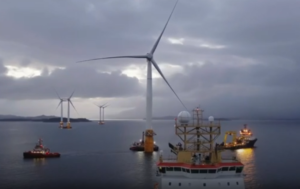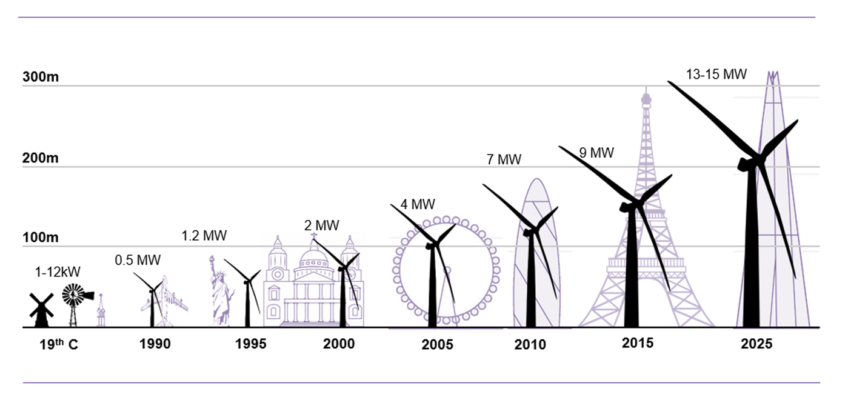By Doug Bogen, SAPL Director
Published in SeacoastOnline
There is a revolution taking place just off the Northeast U.S. coast, a key part of a necessary transition away from the fossil fuels that threaten our future climate. The siting and installation of huge offshore wind turbines and other ocean technologies promise to provide the bulk of our power needs in future decades. As with all renewable power sources, these technologies once installed will harness practically free energy for a resilient, reliable and safe power grid throughout our energy-starved region.
 Though it’s a distant, nostalgic memory for most people now, there was time over a hundred years ago when naturally free energy sources were tapped on a regular basis in our region as well as others. The long legacy of wind and water powered technologies like sailing ships and waterwheels once enabled most of the transport, manufacturing and other commerce in 17th through 19th century New England. It also directly led to the founding and expansion of most of our cities and towns throughout the region, a geography that exists to this day – even if the water-based power sources that led to it are rarely employed or appreciated today, except as tourist attractions or increasingly scarce hydropower facilities. Our smaller deep water ports – north of Boston that is – have languished in comparison with the previous century, or have increasingly specialized their operations to import critical commodities for the region, like coal, oil or salt.
Though it’s a distant, nostalgic memory for most people now, there was time over a hundred years ago when naturally free energy sources were tapped on a regular basis in our region as well as others. The long legacy of wind and water powered technologies like sailing ships and waterwheels once enabled most of the transport, manufacturing and other commerce in 17th through 19th century New England. It also directly led to the founding and expansion of most of our cities and towns throughout the region, a geography that exists to this day – even if the water-based power sources that led to it are rarely employed or appreciated today, except as tourist attractions or increasingly scarce hydropower facilities. Our smaller deep water ports – north of Boston that is – have languished in comparison with the previous century, or have increasingly specialized their operations to import critical commodities for the region, like coal, oil or salt.

In the 21st century, a growing recognition of the need to get off our fossil fuel addiction as well as rely more on cleaner, highly efficient electrical energy throughout our economy has led to growing demand — and lower costs – for renewable power development. Fortunately, the Northeast, and the Gulf of Maine in particular, turn out to be among the best regions in all of North America for offshore wind development. The U.S. Department of Energy calculates that there is a total potential wind power resource in the Gulf of Maine – from Cape Cod to Eastport, Maine – of more than 200,000 megawatts. That’s more than six times the existing power capacity of all the New England states.
The state of Maine has already set an ambitious goal of 5,000 megawatts of power – that’s equivalent to four Seabrook plants from offshore wind turbines by 2030. Combined with other renewable power sources, this is more than enough to power the whole state. Getting all this built and maintained off the coast of Maine is projected to bring $20 billion to the state economy and produce 16,700 jobs over 20 years. The state has been collaborating with private industry on this plan, which calls for building at least 600 turbines and platforms, or one every week through 2030. Why shouldn’t New Hampshire share in a portion of this economic development and encourage power generation off our shores?
 To tap this resource on the scale needed, we’re talking about the construction of hundreds of huge floating wind turbine platforms, each larger than a 747 jet on-end, which would be towed out to appropriate sites far offshore, moored to the ocean bottom and connected by undersea cables to bring the power onshore. This may sound like science fiction, but the future is now – there have been full-scale floating turbines operating off the shores of Portugal, Norway and Japan. Most recently a Norwegian company has built the world’s first floating wind farm off northern Scotland (photo above).
To tap this resource on the scale needed, we’re talking about the construction of hundreds of huge floating wind turbine platforms, each larger than a 747 jet on-end, which would be towed out to appropriate sites far offshore, moored to the ocean bottom and connected by undersea cables to bring the power onshore. This may sound like science fiction, but the future is now – there have been full-scale floating turbines operating off the shores of Portugal, Norway and Japan. Most recently a Norwegian company has built the world’s first floating wind farm off northern Scotland (photo above).
Closer to home, an 1/8-scale, grid-tied turbine was installed off Castine, Maine, a few years ago, and a full-scale 12-megawatt floating wind farm is slated to be sited off Monhegan Island by the end of 2019. Meanwhile, Massachusetts committed last year to 1,600 megawatts of offshore wind, at a federally-approved site south of Martha’s Vineyard that could eventually accommodate five times that capacity, while Rhode Island has seen the first offshore wind farm in the country get up and running earlier this year off Block Island.
While wind is fairly consistent throughout the Gulf, existing deep-water ports and marine industrial facilities are not – there are only so many available to build and maintain the numerous offshore wind farms needed to tap this resource. Facilities in Maine and states south of us are gearing up to provide staging areas for massive offshore wind development, yet to date there has been no similar effort here. Why is New Hampshire ignoring and missing out on this offshore energy rush?
The Portsmouth City Council has a resolution before it that would send a message to Gov. Sununu that we want to see this kind of development off our shores, and that he should act quickly to request formation of an intergovernmental task force by federal authorities, as almost every other eastern coastal state has already done.

Dover and Durham councils have already approved similar resolutions, and other Seacoast communities are being approached for town meeting votes. A council vote on the resolution is expected on Monday, Oct. 2, so Portsmouth residents and others concerned with climate action and/or sustainable energy are encouraged to come to the meeting and support this first step toward renewing and updating our maritime legacy for a sustainable 21st century.

